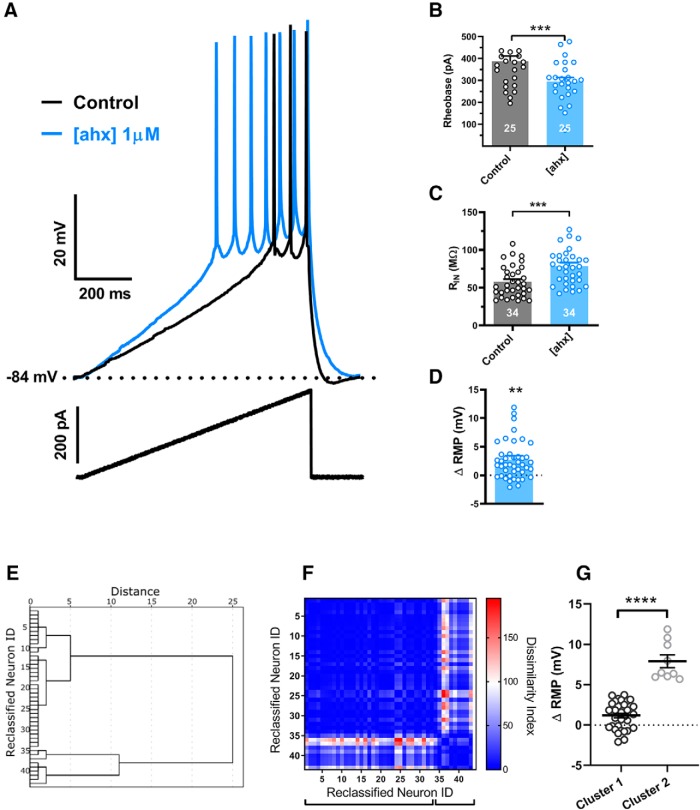Figure 2.
[ahx5–24]NPY increases BLA principal neuron excitability. A, Responses of a representative PN to a depolarizing current ramp (bottom) under control conditions (black) and following bath application of [ahx5–24]NPY (1 μm) (blue) (K+-gluconate internal). Following Y2R agonist treatment, AP firing from the RMP was evoked with substantially less current. B, Depolarizing current magnitude (rheobase) required to elicit PN AP firing from RMP under control conditions and following bath application of [ahx5–24]NPY (1 μm). Twenty-five of 30 PNs responded to the Y2R agonist with a significant reduction in rheobase (control, 387.2 ± 24.2 pA; [ahx5–24]NPY, 294.7 ± 18.8 pA; t(24) = 7.365; p < 0.0001; n = 25 cells, 21 rats; Student's paired t test). C, PN input resistance under control conditions (black) and following bath application of [ahx5–24]NPY (1 μm). Thirty-four of 41 PNs tested responded to the Y2R agonist with significantly increased input resistance from 59.03 ± 4.17 to 80.63 ± 5.40 mΩ (t(33) = 9.467; p < 0.001; n = 34 cells, 21 rats; Student's paired t test). In these PNs, the Y2R agonist also elicited a small but significant overall depolarization from −81.3 ± 0.8 to −79.6 ± 1.1 mV (t(33) = 2.757; p = 0.0094; n = 34 cells, 21 rats; Student's paired t test). D, Although effects of the Y2R agonist on PN RMP were inconsistent, overall [ahx5–24]NPY (1 μm) caused a modest but significant RMP depolarization from −80.9 ± 0.7 to −78.2 ± 0.8 mV (t(44) = 3.482; p < 0.0011; n = 45 cells, 25 rats; Student's paired t test). E, Dendrogram of a hierarchical cluster analysis performed on ΔRMP of PNs following application of [ahx5–24]NPY (1 μm). F, Proximity matrix of a hierarchical cluster analysis using squared Euclidean distance on Δ RMP of PNs following application of [ahx5–24]NPY (1 μm). Neurons were reclassified based on similarity for graphical representation. G, Scatter plot depicting the heterogeneous RPM response profile in BLA PNs following application of [ahx5–24]NPY (1 μm). Responses fall robustly into two distinct clusters (t = 10.01, df = 41, p < 0.0001). **p < 0.01, ***p < 0.001, ****p < 0.0001.

